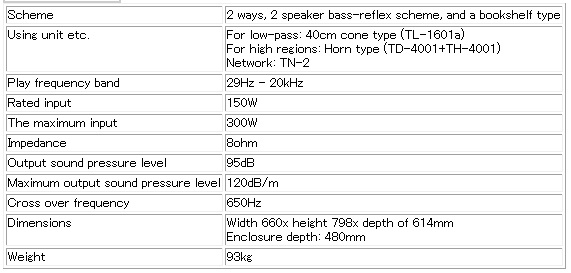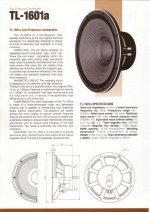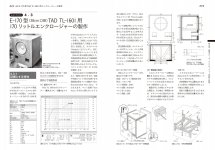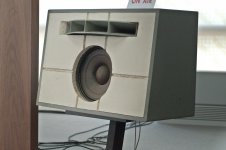There's a rule of thumb, which usually distinguishes technically advanced concepts with perfect measurement data from similar loudspeakers that were developed with the (subjective) sonic performance in mind:
"Never use a woofer with a Mms >80g above 500Hz."
There's much more to this statement, but it basically comes down to the handover between the woofer and the, preferably 3", compression driver diaphragm.
You don't need a PhD in physics to 'see' why a 120g cone crossed to an 1.75" diaphragm is a recipe for 'shortcomings' in the midrange, despite benchmark measurement data.
It's not surprising that Gary Dahl eventually choose the GPA416, because this is one the best 15" midwoofers.
The TD15M is a comparable driver.
Cheaper alternatives are the Faital 15PR400 and the Eminence Deltalite II 2515.
"Never use a woofer with a Mms >80g above 500Hz."
There's much more to this statement, but it basically comes down to the handover between the woofer and the, preferably 3", compression driver diaphragm.
You don't need a PhD in physics to 'see' why a 120g cone crossed to an 1.75" diaphragm is a recipe for 'shortcomings' in the midrange, despite benchmark measurement data.
It's not surprising that Gary Dahl eventually choose the GPA416, because this is one the best 15" midwoofers.
The TD15M is a comparable driver.
Cheaper alternatives are the Faital 15PR400 and the Eminence Deltalite II 2515.
Last edited:
A MTM configuration:
And what are these, please? Do they also feature 2235H's?
How have the 2235H's been "completely rebuilt"? Sounds like marketing speak.
I guess they've been reconed. What else could be done? Remagging, for instance, isn't necessary for those ferrite magnet drivers (quite contrary to the older AlNiCo units, btw.).
Genuine C8R2235 kits still are available from JBL, albeit at many $$$
Best regards!
There's a rule of thumb, which usually distinguishes technically advanced concepts with perfect measurement data from similar loudspeakers that were developed with the (subjective) sonic performance in mind:
"Never use a woofer with a MMS >80g above 500Hz."
There's much more to this statement, but it basically comes down to the handover between the woofer and the, preferably 3", compression driver diaphragm.
You don't need a PhD in physics to 'see' why a 120g cone crossed to an 1.75" diaphragm is a recipe for 'shortcomings' in the midrange.
Oops, the 2235H's Mms is 155 g
Best regards!
There's a rule of thumb, which usually distinguishes technically advanced concepts with perfect measurement data from similar loudspeakers that were developed with the acoustic perception in mind.
Never use a woofer with a MMS >80g above 500Hz.
There's much more to this statement, but it basically comes down to the handover between the woofer and the, preferably 3", compression driver diaphragm.
You don't need a PhD in physics to 'see' why a 120g cone crossed to an 1.75" diaphragm is a recipe for 'shortcomings' in the midrange.
Mms on its own means nothing.
It's the ratio of the electromagnetic force factor (BL^2/Re) to Mms that matters w.r.t. faithfully reproducing higher frequencies. And lo and behold, that is directly proportional to the Efficiency Bandwith Product (Fs/Qes).
I don't mean to come across as snarky, but... while one may not need a PhD in physics, some understanding of the actual physics at play would certainly help.
And alas, intuitive "rules of thumb" rarely cut the mustard.
Amicably,
Marco
And what are these, please? Do they also feature 2235H's?
These were built by PBN, it's a custom version of the 2!5 in a MTM config with PBN's Montana 6 sided cabinet.
Mms on its own means nothing.
It's the ratio of the electromagnetic force factor (BL^2/Re) to Mms that matters w.r.t. faithfully reproducing higher frequencies. And lo and behold, that is directly proportional to the Efficiency Bandwith Product (Fs/Qes).
I don't mean to come across as snarky, but... while one may not need a PhD in physics, some understanding of the actual physics at play would certainly help.
And alas, intuitive "rules of thumb" rarely cut the mustard.
Amicably,
Marco
I deleted the EBP part from my post, that's why I stated "there's much more to this". EBPs of TAD woofers were considered benchmarks for a long time.
Still, I think the rule of thumb applies.
Electrically and mechanically "faithfully reproducing higher frequencies" still doesn't automatically translate into a sonically 'correct' midrange, but I admit it's an important aspect in loudpeaker design.
An example:
While I consider myself a JBL afficionado, (like others) I think the D67000's midrange leaves some things to be desired.
Last edited:
You'll end up with something similar to this:

which is a clone of this:

Which is one example to cover (almost) the whole spectrum, high spl, low distortion with a 2-way.

(I like the description "bookshelf type". Provided your bookshelves are made of reinforced concrete or the kind you find in warehouses, it's legit)

which is a clone of this:

Which is one example to cover (almost) the whole spectrum, high spl, low distortion with a 2-way.

(I like the description "bookshelf type". Provided your bookshelves are made of reinforced concrete or the kind you find in warehouses, it's legit)
Last edited:
No!
to the question: "Is it possible to cover the whole spectrum, high spl, low distortion with a 2-way?"
To meet this mission at the bottom end of the audio spectrum, requires multiple drivers operated under servo-control. This is the only way to get low distortion at large displacement in a reasonable sized footprint, while mitigating room mode issues as well.
In this setting, the first c/o will be set, at say 100 Hz, to avoid imaging issues that occur at higher frequencies.
Thus, at least one additional c/o point will be required to separate the speech range from the rest.
At the top end, pattern control will be at issue.
Of course the mid range, will always be were distortion products are most noticeable, because that is where the ear is most sensitive to acoustic energy.
WHG
to the question: "Is it possible to cover the whole spectrum, high spl, low distortion with a 2-way?"
To meet this mission at the bottom end of the audio spectrum, requires multiple drivers operated under servo-control. This is the only way to get low distortion at large displacement in a reasonable sized footprint, while mitigating room mode issues as well.
In this setting, the first c/o will be set, at say 100 Hz, to avoid imaging issues that occur at higher frequencies.
Thus, at least one additional c/o point will be required to separate the speech range from the rest.
At the top end, pattern control will be at issue.
Of course the mid range, will always be were distortion products are most noticeable, because that is where the ear is most sensitive to acoustic energy.
WHG
Last edited:
Of course, that's why I said: "(almost) the whole spectrum".
I guess most of us are aware of the requirements to reproduce <40Hz.
GM stated something similar a few pages ago.
That's without taking room modes into consideration.
Camplo has already decided to seperate midbass and (sub)bass (split between the TD15M and TD15H).
What do you end up with, if you want to squish 1-1.5 bottom octave out of the TAD (based) 2-ways?
With this:
Pretty ugly and according to people whose opinion I value: sonically pretty crappy as well.
I guess most of us are aware of the requirements to reproduce <40Hz.
GM stated something similar a few pages ago.
That's without taking room modes into consideration.
Camplo has already decided to seperate midbass and (sub)bass (split between the TD15M and TD15H).
What do you end up with, if you want to squish 1-1.5 bottom octave out of the TAD (based) 2-ways?
With this:
An externally hosted image should be here but it was not working when we last tested it.
Pretty ugly and according to people whose opinion I value: sonically pretty crappy as well.
Last edited:
Of course the mid range, will always be were distortion products are most noticeable, because that is where the ear is most sensitive to acoustic energy.
WHG
And this IMHO is still one of the most overlooked/undervalued aspects, even by professionals in the field.
And it is not only about absolute levels of distortion, it is also about synergy between components and their impact on reproduction.
This is an art that includes science, but also a kind of craftsmanship.
Illustrious products such as the WE594A and the JBL 375 have been developed in this way.
Example:
I have met more than a handful of classically trained musicians who prefer Audio Note speakers to everything they have heard.
As is apparent from his photobucket account, Gary Dahl is one of the probably hundreds worldwide, including some renowned producers.
What is the basis for this?
If you ask those musicians, you get answers such as:
Only on AN does a piano sound like a piano, a cello like a cello, the air around instruments is rendered more convincingly, etc.
I'm not a fan of Audio Note. I detest the boundary loading which makes them sound thin free standing in larger rooms. I must admit, however, that the overall sonic performance is something special. It is also true that most of their loudspeakers render all sorts of music equally well, including less than stellar recordings.
Audio Note hardly does any marketing. Their primary marketing tool is word of mouth advertising and I think this is telling. This company has been flourishing for decades, regardless of the economic climate.
For similar reasons, a number of reviewers, apparently not yet poisoned by an overdose of mediocre high-end products, rated the 1947 WE754A monitor 'best of show' on a recent Munich High-End.
This is an art that includes science, but also a kind of craftsmanship.
Illustrious products such as the WE594A and the JBL 375 have been developed in this way.
Example:
I have met more than a handful of classically trained musicians who prefer Audio Note speakers to everything they have heard.
As is apparent from his photobucket account, Gary Dahl is one of the probably hundreds worldwide, including some renowned producers.
What is the basis for this?
If you ask those musicians, you get answers such as:
Only on AN does a piano sound like a piano, a cello like a cello, the air around instruments is rendered more convincingly, etc.
I'm not a fan of Audio Note. I detest the boundary loading which makes them sound thin free standing in larger rooms. I must admit, however, that the overall sonic performance is something special. It is also true that most of their loudspeakers render all sorts of music equally well, including less than stellar recordings.
Audio Note hardly does any marketing. Their primary marketing tool is word of mouth advertising and I think this is telling. This company has been flourishing for decades, regardless of the economic climate.
For similar reasons, a number of reviewers, apparently not yet poisoned by an overdose of mediocre high-end products, rated the 1947 WE754A monitor 'best of show' on a recent Munich High-End.
Attachments
Last edited:
I don't think I can do any better then what I have planned at this point. I've acquired power, which comes complete with enough eq for voicing/room correction. The acoustic elegance drivers are designed by smart people, the excursion of the 15H is directly outlined by xmax and xmech vs rms and peak, can play down to 20hz without bottoming out at 500rms. The 15m is held in high regard. Looking at crossing at 130hz and 600-700hz....I feel next year I could upgrade to beryllium diaphragms, based on what I think of the aquaplased titanium....I also have these krk s4v4 2 ways I love. I'll be switching those into rotation to try a 4 way first hand.....which brings me to an issue I have over looked....how the hell do I turn 2 outputs into 6 inputs....just when I though, I couldn't find another problem to solve!!!
ps- Audio Note you say? Commencing research.
ps- Audio Note you say? Commencing research.
Last edited:
I think you're on the right track, considering your intentions and your preferences.
The 15H/15M combo makes a lot more sense compared to mid + dual subwoofer configuration of the Ocean Way monitor above.
This is an example of the 'synergy' I referred to.
What you'll get is complementary output and 'sonic signature'. IOW, these drivers are not worlds apart, but designed by the same company for slightly different applications.
Audio Note speakers won't meet your requirements.
The 15H/15M combo makes a lot more sense compared to mid + dual subwoofer configuration of the Ocean Way monitor above.
This is an example of the 'synergy' I referred to.
What you'll get is complementary output and 'sonic signature'. IOW, these drivers are not worlds apart, but designed by the same company for slightly different applications.
Audio Note speakers won't meet your requirements.
How hasn't this been done before? (Tractrix/CD+15m sealed + 15h ported)....Do I get to name my design? I already have a name picked out. My approach with the active eq'd amps is slightly unique and repeatable as well as frugal yet should deliver sonically. I don't know how fancy I can get with the baffle but I'm pretty good at finish design.
In all likelihood the Ocean Way monitor will sound like a big 2 way with an add-on car subwoofer.
Similar to some Avantgarde systems, where the separate sub does not harmonize at all with the large mid horn,
or large electrostatic speakers with separate subs (Martin Logan ao.).
I think it's been done before.
Gary Dahl's system is close to your concept, except for the passive radiators accompanying the 15H.
If your woodworking skills are adequate, you might want to consider a curved baffle. With this I mean a (nearly) half sphere.
Roundovers for big cabs are pretty useless, unless these approach.... exactly, a hemisphere.
Similar to some Avantgarde systems, where the separate sub does not harmonize at all with the large mid horn,
or large electrostatic speakers with separate subs (Martin Logan ao.).
I think it's been done before.
Gary Dahl's system is close to your concept, except for the passive radiators accompanying the 15H.
If your woodworking skills are adequate, you might want to consider a curved baffle. With this I mean a (nearly) half sphere.
Roundovers for big cabs are pretty useless, unless these approach.... exactly, a hemisphere.
Last edited:
- Home
- Loudspeakers
- Multi-Way
- Is it possible to cover the whole spectrum, high SPL, low distortion with a 2-way?


